Journal of Computer and Communications, 2018, 6, 215-221
http://www.scirp.org/journal/jcc
ISSN Online: 2327-5227
ISSN Print: 2327-5219
Summary of Research Status and Application of
MEMS Accelerometers
Weimeng Niu, Liqing Fang*, Lei Xu, Xu Li, Ruikun Huo, Deqing Guo, Ziyuan Qi
Army Engineering University Shijiazhuang Campus, Shijiazhuang, China
How to cite this paper: Niu, W.M., Fang,
L.Q., Xu, L., Li, X., Huo, R.K., Guo, D.Q.
and Qi, Z.Y. (2018) Summary of Research
Status and Application of MEMS Accele-
rometers. Journal of Computer and Com-
munications, 6, 215-221.
https://doi.org/10.4236/jcc.2018.612021
Received: December 19, 2018
Accepted: December 27, 2018
Published: December 30, 2018
Abstract
The rapid development of MEMS technology has made MEMS accelerome-
ters mature and the application range has been expanded. Many kinds of
MEMS accelerometers are researched. According to the working principle of
MEMS accelerometer, it can be divided into: piezoresistive, piezoelectric, ca-
pacitive, tunnel, resonant, electromagnetic, thermocouple, optical, inductive,
etc. Due to its outstanding features in terms of size, quality, power consump-
tion and reliability, MEMS sensors are used in military applications and
where high environmental resistance is required. MEMS accelerometers are
developing rapidly and have good application prospects. In order to make
MEMS accelerometers more widely understood, the advantages of MEMS ac-
celerometers are expounded. The research status of MEMS accelerometers is
introduced, and MEMS are analyzed. The application of accelerometers in
real-world environments, and the development trend of MEMS accelerome-
ters in the future. More scholars will invest in MEMS accelerometer research,
pursuing high performance, low power consumption, high precision, mul-
ti-function, and interaction. Strong MEMS accelerometers will be ubiquitous
in the future.
Keywords
MEMS Technology, MEMS Accelerometer
1. Introduction
The sensor based on MEMS technology is generally a highly integrated sensor
system integrating micro-mechanical and micro-electronic functions, which is
made of silicon-based materials and semiconductor integrated circuit manufac-
turing process. It has remarkable small size, light weight and low power con-
sumption. Low cost, high reliability, strong resistance to vibration and shock,
DOI: 10.4236/jcc.2018.612021 Dec. 30, 2018
215
Journal of Computer and Communications
�
W. M. Niu et al.
DOI: 10.4236/jcc.2018.612021
etc. At the same time, feature sizes on the order of micrometers allow them to
perform functions that are not possible with some conventional sensors. The
MEMS products currently being developed are mainly microelectromechanical
sensors including MEMS gyroscopes, microelectromechanical accelerometers
and micro pressure gauges [1]. Due to its outstanding features in terms of size,
quality, power consumption and reliability, MEMS sensors are used in military
applications and where high environmental resistance is required.
2. Advantages of MEMS Accelerometers
MEMS accelerometers are developing rapidly and have good application pros-
pects. Their application advantages are mainly reflected in the following aspects:
1) The sensor is small in size and has high measurement accuracy. The micro
accelerometer has experienced technical solutions such as interdigital, sandwich,
and resonant beam. The zero bias and scale factor are 10 mg from 2005 to 20 ug
in 2005. The micro-miniature two-axis accelerometer successfully developed by
Analog Devices is only 5 mm × 5 mm × 1.45 mm, with a mass of less than 1 g
and a resolution of 10−3. The silicon microgyroscope ADXRS series measures 7
mm × 7 mm × 3 mm and has a mass of less than 1 g. Continuous innovation of
technical solutions reduces the source of error from the working mechanism and
improves the accuracy.
2) High degree of integration, which can be mass-produced. Through the
MEMS process, integration of multiple sensors with different functions and sen-
sitive directions can be realized to form a micro-sensor array or micro-system.
Similar to microelectronic chips, MEMS devices can be mass-produced and have
low production costs, which is conducive to the industrialization of MEMS
products.
3) Passivation can be achieved. In the Internet of Things era, networked mea-
surement and control systems often require wireless MEMS sensors. As a sensor
that converts non-electricity into electricity, power is a key point. The energy
harvesting chip collects other energy sources such as solar energy and wind
energy, and then converts it into electric energy to supply power to the sensor.
The combination of the wireless sensing module and the energy harvesting
technology will make the MEMS sensor passive.
3. Research Status of MEMS Accelerometer
According to the working principle of MEMS accelerometer, it can be divided
into: piezoresistive, piezoelectric, capacitive, tunnel, resonant, electromagnetic,
thermocouple, optical, inductive, etc. A typical MEMS accelerometer is intro-
duced.
3.1. Piezoresistive Acceleration Sensor
The basic principle of the MEMS piezoresistive accelerometer is the piezoresis-
tive effect. The inductive component is a varistor fabricated on a sensitive film or
216
Journal of Computer and Communications
�
W. M. Niu et al.
a sensitive beam. The sensing process is: when the object generates motion, the
mass inside the accelerometer will under the action of the inertial force, the up
and down motion is generated. Since the mass is supported by the cantilever
beam, under the traction of the moving mass, the varistor located on the canti-
lever beam is deformed, and the resistance value changes, resulting in the power
supply in Wheatstone. A small ripple voltage is generated in the bridge circuit,
and the output signal of the Wheatstone bridge is amplified by the readout cir-
cuit, and the magnitude of the corresponding acceleration can be calculated by
the calibration rule, and the change trend of the acceleration reflects the moving
direction of the target [2] [3]. Figure 1 is a physical diagram of MEMS piezore-
sistive acceleration. For the MEMS piezoelectric acceleration sensor, only the va-
ristor is replaced by a piezoelectric piece, and the piezoelectric effect is used to
detect the acceleration change, and the working principle is similar to the piezo-
resistive type. The MEMS piezoresistive accelerometer is a micro-acceleration
sensor that was studied earlier. It has formed a relatively mature design theory
system in the course of many years of research, and it has been applied in prac-
tice in the 1980s. The main disadvantages of piezoelectric and piezoresistive ac-
celerometers include the material's obvious fatigue effect, low sensitivity, large
nonlinear error, and easy exposure to temperature. Future developments focus
on improving sensitivity and reducing cross-coupling [4].
3.2. Capacitive Accelerometer
MEMS capacitive accelerometers use the change of capacitance to test the acce-
leration change, which is one of the most widely used methods in many mea-
surement methods [5]. The sensor is generally composed of a sensitive structure
and a fixing mechanism, and constitutes a variable capacitance dynamic capaci-
tor. When the acceleration changes, the capacitance between the sensitive struc-
ture and the fixing mechanism also changes, and the peripheral detection circuit
can the amount of change is tested and the value of the true acceleration of the
object can be measured indirectly based on the acceleration calibration. MEMS
capacitive accelerometers have the advantages of low energy consumption, good
linearity, high measurement accuracy, stable test process, etc. At the same time,
there are also defects such as complex signal processing circuits and poor an-
ti-electromagnetic interference capability. COMS integration, single-chip mul-
ti-axis and other directions. The capacitive accelerometer is shown in Figure 2.
DOI: 10.4236/jcc.2018.612021
Figure 1. Piezoresistive accelerometer.
217
Journal of Computer and Communications
�
W. M. Niu et al.
Figure 2. Capacitive accelerometer.
3.3. Tunnel Accelerometer
Using tunneling to study the displacement and tunneling current is the basic
principle of MEMS tunneling accelerometer [6]. At room temperature, when the
distance between the two electrodes is very close, the voltage of the electric field
is continuously enhanced by the excitation of the geometric shape and the like.
When the reduction is small enough, the electrons between the metal electrodes
will actively penetrate. Generate tunnel current. When subjected to inertial
force, the sensitive block is displaced, and the distance between the electrodes
changes. By measuring the value of the current, the magnitude of the external
acceleration can be calculated. These sensors are characterized by strong an-
ti-interference ability, high reliability, easy detection, and small temperature ef-
fect. However, since quantum effect is the basis of such sensors, the theoretical
model is relatively immature and based on the volume and size of MEMS tun-
nel-type accelerometers. The limitation is greatly affected by noise and the man-
ufacturing process is also complicated.
3.4. Resonant Accelerometer
The MEMS resonant accelerometer uses the frequency signal to achieve the
purpose of measurement [7]. The resonant beam is the core component of such
an accelerometer. When the object has an acceleration output, the inertial force
drives the mass to vibrate, and the resonant beam is in the mass. The deforma-
tion occurs under the influence of the natural frequency. By detecting the re-
sonance frequency in this process, the excitation amount is calculated and the
magnitude of the acceleration is obtained. The MEMS resonant accelerometer
can detect the frequency signal of the moving object and use the characteristics
of the remaining input acceleration to achieve the purpose of measuring the ac-
celeration. Since the frequency signal approximates the digital signal, it can be
directly accepted by the digital processing chip, so it has a good resolution. And
the sensitivity, the detection circuit is very simplified, and the stability is high in
the process of signal transmission. However, since it takes a long time to inte-
grate its high-resolution signal, realizing its rapid real-time detection is the de-
velopment direction of such sensors.
With the continuous development of science and technology, the types of
MEMS accelerometers are continuously enriched, and the limitations are be-
coming smaller and smaller. Devices developed with new principles are con-
218
Journal of Computer and Communications
DOI: 10.4236/jcc.2018.612021
�
W. M. Niu et al.
stantly emerging. The thermal convection acceleration sensor designed by tem-
perature difference has good structural stability and strong impact resistance.
The accelerometer based on acousto-optic effect breaks through the compatible
processing technology of single crystal quartz body processing and patterning;
using magnetic fluid to design acceleration sensor to overcome the common
sensor contact points wear each other. In addition, there are fiber-optic, laser
self-mixing effect, thermocouple type, the new principle is more prominent in
the new sensor, and the application in weapons and equipment will be more ex-
tensive.
4. MEMS Accelerometer Application Status
MEMS accelerometers are widely used in many fields. The wearable data device
SCUPPY developed by Samsung uses gyroscopes to sense the direction of mo-
tion, and MEMS accelerometers sense the motion generated by finger move-
ments; Cao Yuzhen et al. [8] The human body falls or not, and the human body
attitude detection technology is developed with the MEMS accelerometer as the
core. The acceleration vector magnitude and the differential value of the vector
amplitude are used to sense the movement of the human body. In the field of
human-computer interaction, Nintendo launched the WII game controller.
MEMS accelerometer is used to detect and identify any space motion [9] [10]; Su
Weijia [11] and other integrated accelerometers and microprocessors design an
automotive brake detection system that can intelligently and conveniently detect
the brakes of the car. Stability and braking efficiency; the small size of the MEMS
accelerometer makes it suitable for portable ultra-small-sized consumer prod-
ucts such as mobile phones and notebook computers [12]; MEMS accelerome-
ters have been moving toward high precision and high integration. It has been
able to meet equipment guidance and control in terms of accuracy required [13].
The PIMPF (Programmable Intelligent Multi-Purpose Fuze) fuze developed by
Germany and France and the MEHTF (Multiple-Event Hart Target Fuze) de-
veloped by the United States on the basis of HTSF (Hart Target Smart Fuze) are
two representative intelligent penetration fuzes. High G-value accelerometer for
acceleration signal recognition and signal acquisition, data processing and burst
control using a microcontroller [14]; France uses a MEMS accelerometer to de-
sign a smart fuze that can withstand an impact of approximately 100,000 G. The
fuze can send the necessary information such as the reached depth and the
number of layers penetrated to the projectile control system at the moment of
the detonation of the projectile, and perform intelligent analysis processing in
the background. According to the relevant information of the process, the fuze
can be obtained. Whether the enemy’s command center was destroyed when the
explosion occurred, and whether the enemy’s command center was destroyed
[15]; the MEMS fuze safety insurance mechanism developed by the US Navy
using MEMS accelerometers has the characteristics of reliability and high adap-
tability to the environment [16]. Inside the fuze, the magnitude of the torpedo
acceleration is transmitted by acceleration The sensor senses, the first insurance
219
Journal of Computer and Communications
DOI: 10.4236/jcc.2018.612021
�
W. M. Niu et al.
DOI: 10.4236/jcc.2018.612021
is released when the predetermined value is reached, and the output signal is
transmitted to the next actuator, which fully displays the intelligent characteris-
tics of the ammunition; the acceleration sensor acts as the MIMU (Micro Inertial
Measurement Unit). The performance of the core device directly determines the
performance of the system. The MIMU is used to detect the attitude of the pro-
jectile during flight. By combining with GPS, the flight path of the projectile can
be accurately detected. The combined system can accurately control the projec-
tile. Detonate the point and correct the ballistics [17].
5. Outlook
With the development of micro-engineering and electronic system integrated
integration design, using FPGA, ASIC, ASIS, SOC, IP, MEMS and other ad-
vanced technologies to achieve system-level miniaturization and integrated de-
sign, it will be a design style of military aircraft in the 21st century. MEMS tech-
nology is developing rapidly and has outstanding features. Various types of ac-
celerometers based on MEMS have been widely used in various fields such as
industry, aviation, military, communications, etc. With the continuous ad-
vancement of science and technology, knowledge and technology of various dis-
ciplines are continuously integrated, and scholars of different research directions
are from different sides. Focus on improving and innovating MEMS accelero-
meters. In the era of intelligent Internet of Things, MEMS accelerometers are
welcoming opportunities and facing challenges. More scholars will invest in
MEMS accelerometer research, pursuing high performance, low power con-
sumption, high precision, multi-function, and interaction. Strong MEMS acce-
lerometers will be ubiquitous in the future.
Conflicts of Interest
The authors declare no conflicts of interest regarding the publication of this pa-
per.
References
[1] Amarasinghe, R., Dao, D.V., Toriyama, T., et al. (2007) Development of Miniatu-
rized 6-Axis Accelerometer Utilizing Piezoresistive Sensing Elements. Sensors and
Actuators A: Phsical, 134, 310-320. https://doi.org/10.1016/j.sna.2006.05.044
[2] Tsai, M.H., Liu, Y.C., Sun, C.M., et al. (2010) A CMOS-MEMS Accelerometer with
Tri-Axis Sensing Electrodes Arrays. Procedia Engineering, 5, 1083-1086.
https://doi.org/10.1016/j.proeng.2010.09.298
[3] Kanda, K., Iga, Y., Matsuoka, J., et al. (2010) A Tri-Axial Accelerometer with Struc-
ture-Based Voltage Operation by Using Series-Connected Piezoelectric Elements.
Procedia Engineering, 5, 894-897. https://doi.org/10.1016/j.proeng.2010.09.253
[4] Yoon, K., Soh, S., Seok, B., et al. (2005) A New Wearable Input Device: SCURRY.
IEEE Transaction on Industrial Electronics, 52, 1490-1499.
https://doi.org/10.1109/TIE.2005.858736
[5] Rockstad, H.K., Tang, T.K., Reynolds, J.K., Henny, T.W., Kaiser, W.J. and Gabriel-
son, T.B. (1996) A Miniature High-Sensitivity Electron Tunneling Accelerometer.
220
Journal of Computer and Communications
�
W. M. Niu et al.
Sensors and Actuators A, 53, 227-231.
https://doi.org/10.1016/0924-4247(96)01128-4
[6] Aaltonen, L. and Halonen, K. (2009) Continuous-Time Interface for a Microma-
chined Capacitive Accelerometer with NEA of 4μg and Bandwidth of 300 Hz. Sen-
sors and Actuators A: Phsical, 154, 6-56.
[7] Pinto, D., Mercier, D., Kharrat, C., et al. (2009) A Mall and High Sensitivity Reso-
nant Accelerometer. Procedia Chemistry, 1, 536-539.
https://doi.org/10.1016/j.proche.2009.07.134
[8] Cao, Y.Z., Cai, W.C. and Cheng, W. (2010) Human Body Attitude Detection Tech-
nology Based on MEMS Accelerometer. Nanotechnology and Precision Engineer-
ing, No. 1, 37-40.
[9] Thomas, S., Benjamin, P., Niels, H., et al. (2008) Gesture Recognition with A Wii
Controller. Second International Conference on Tangible and Embedded Interac-
tion-Conference Proceedings, No. 16, 11-14.
[10] Chung, L.J. (2008) Hacking the Nintendo Wii Remote. IEEE Pervasive Computing,
7, 39-45. https://doi.org/10.1109/MPRV.2008.53
[11] Su, W.J. and Su, J. (2008) Application of Acceleration Sensor in Vehicle Braking
Performance Detection. Industrial Control Computer, No. 2, 74-75.
[12] Kevin, T.C.C., Han, D., Ravinder, P.S., et al. (2010) 118-dB Namic Range, Conti-
nuous-Time, Opened-Loop Capactance to Voltage Converter Readout for Capaci-
tive MEMS Accelerometer. Solid State Circuits Conference. IEEE, 1-4.
[13] Chen, W. (2014) Research on Key Technology of High Precision Attitude Mea-
surement Based on MEMS Inertial Sensor. Master’s Thesis, Zhejiang University,
Hangzhou.
[14] Brown, T. and Davis, B. (2001) Strap-Down Micro-Electro-Mechanical (MEMS)
Sensors for Higher Munition Applications. IEEE Transactions on Magnetic, 37,
336-342. https://doi.org/10.1109/20.911850
[15] Dang, A.G. and Li, X.J. (2014) Review and Prospect of the Development of
Earth-Drilling Weapons Abroad. No. 6, 35-39.
[16] Last, H., Deeds, M., Garvic, D., et al. (1999) Nanoto Milli-Meter Scale Integrated
Systems. IEEE/Tansactions on Components and Packaging Technologies, No. 22,
138-142.
[17] Shen, Q. and Li, S.Y. (2002) Calculation of Ballistic Parameters of Ballistic Correc-
tion Fuze Based on MIMU and Its Precision Requirements for MIMU. Journal of
Detection and Control, 24, 35-39.
DOI: 10.4236/jcc.2018.612021
221
Journal of Computer and Communications
�
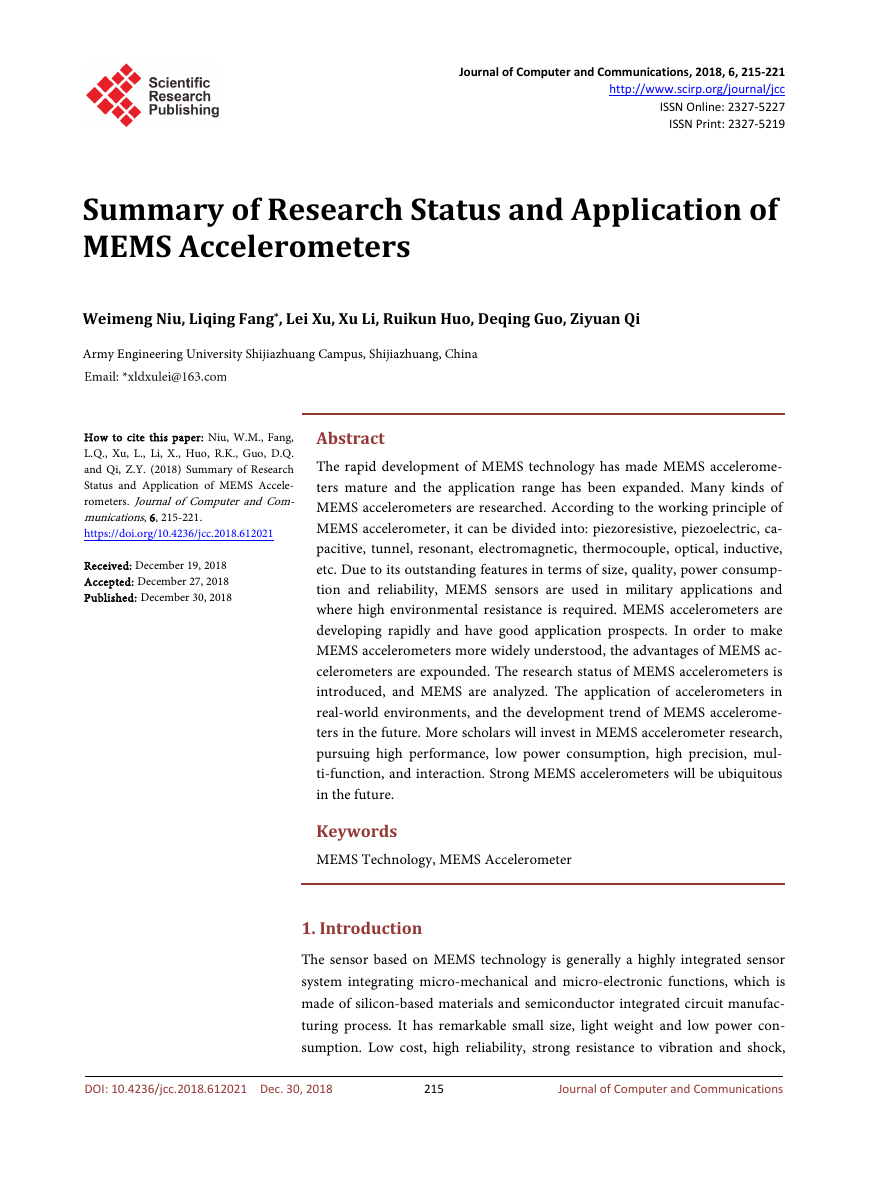
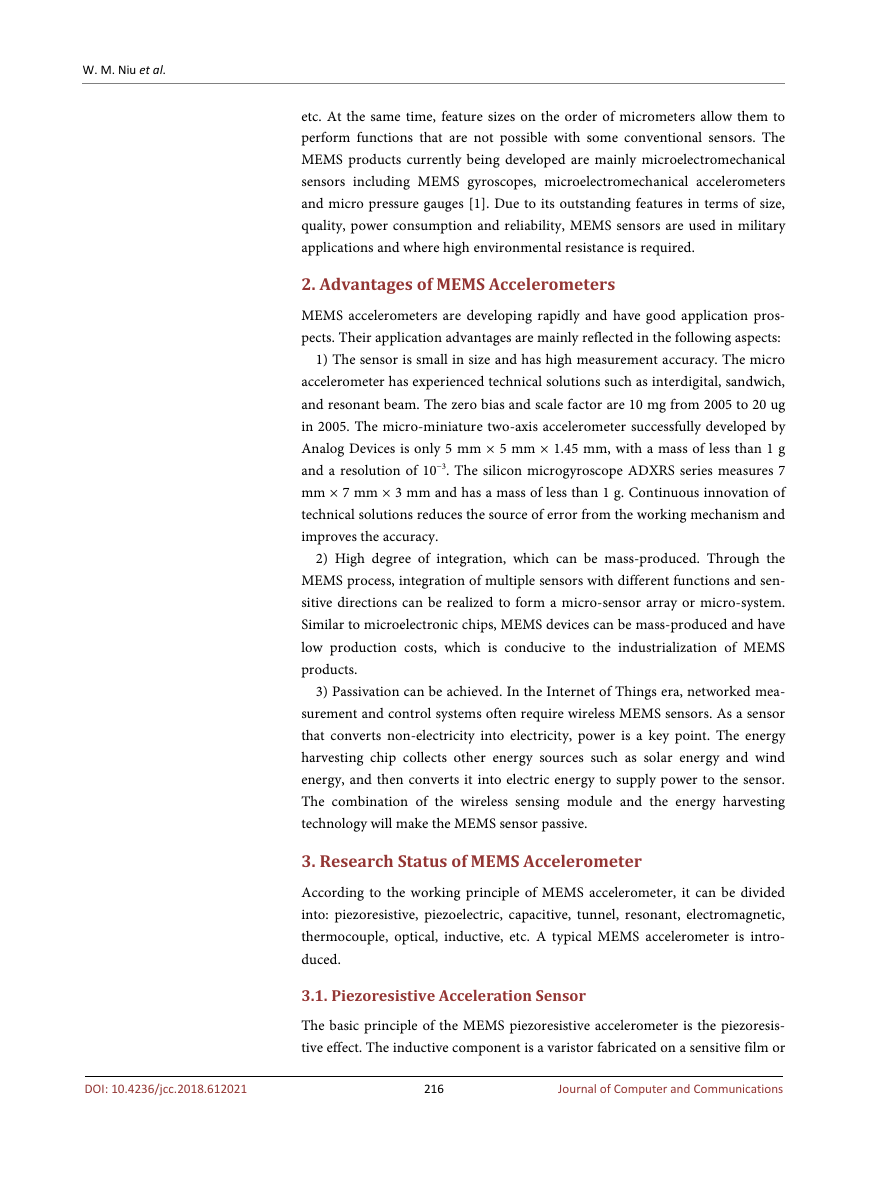
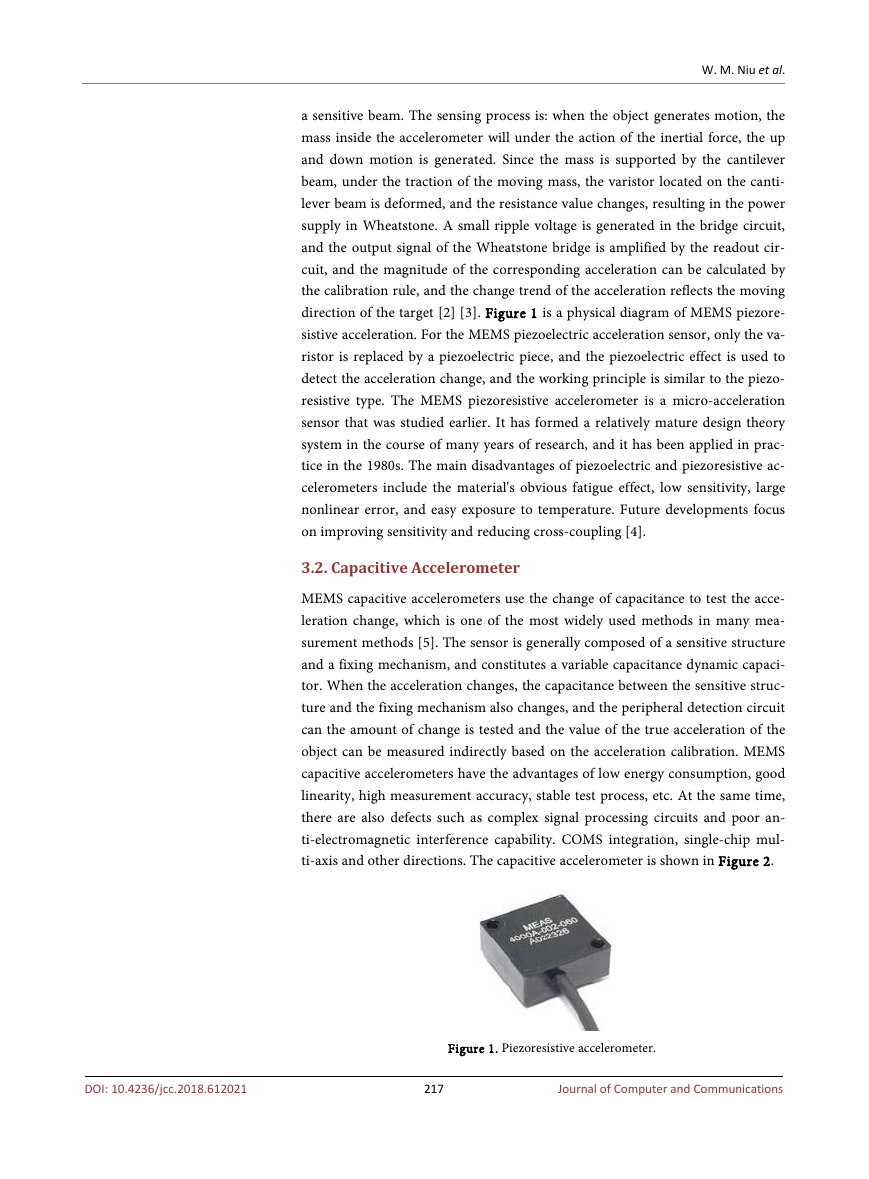
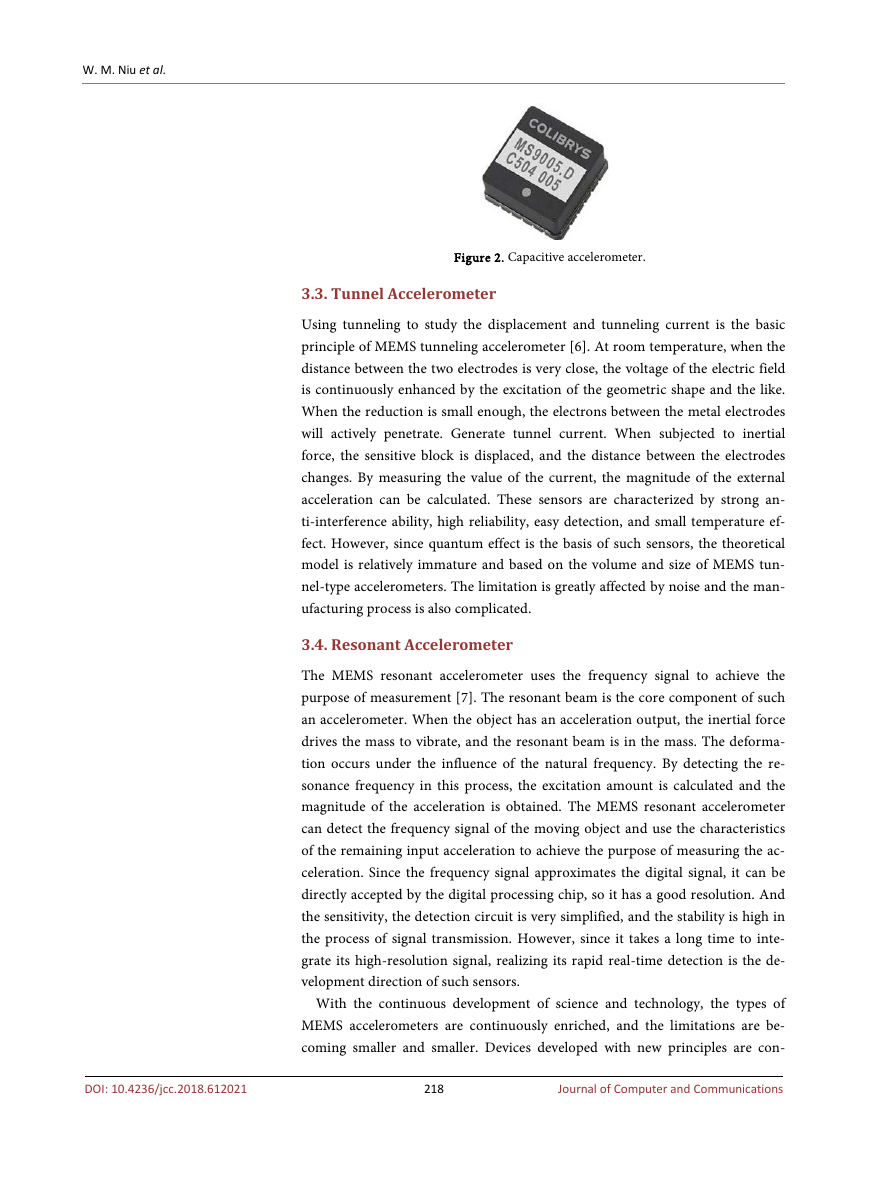
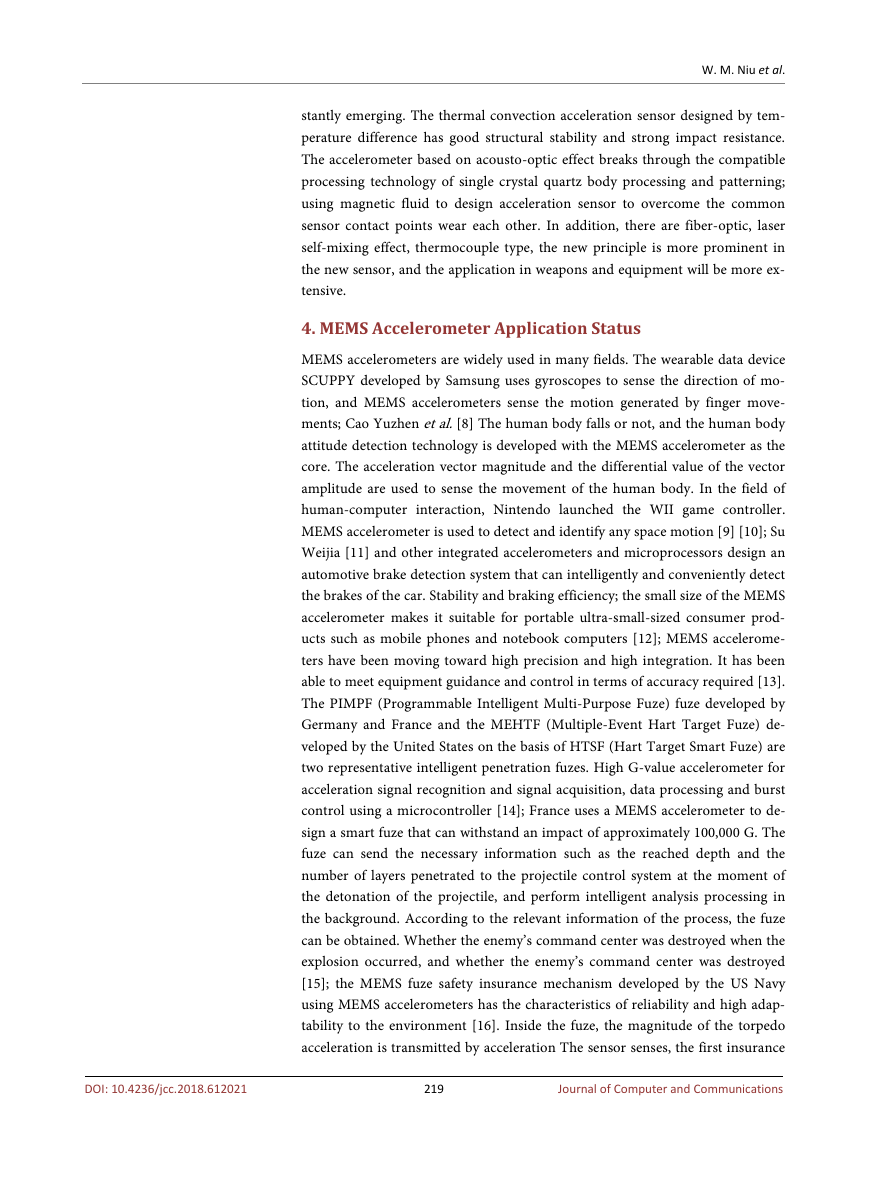
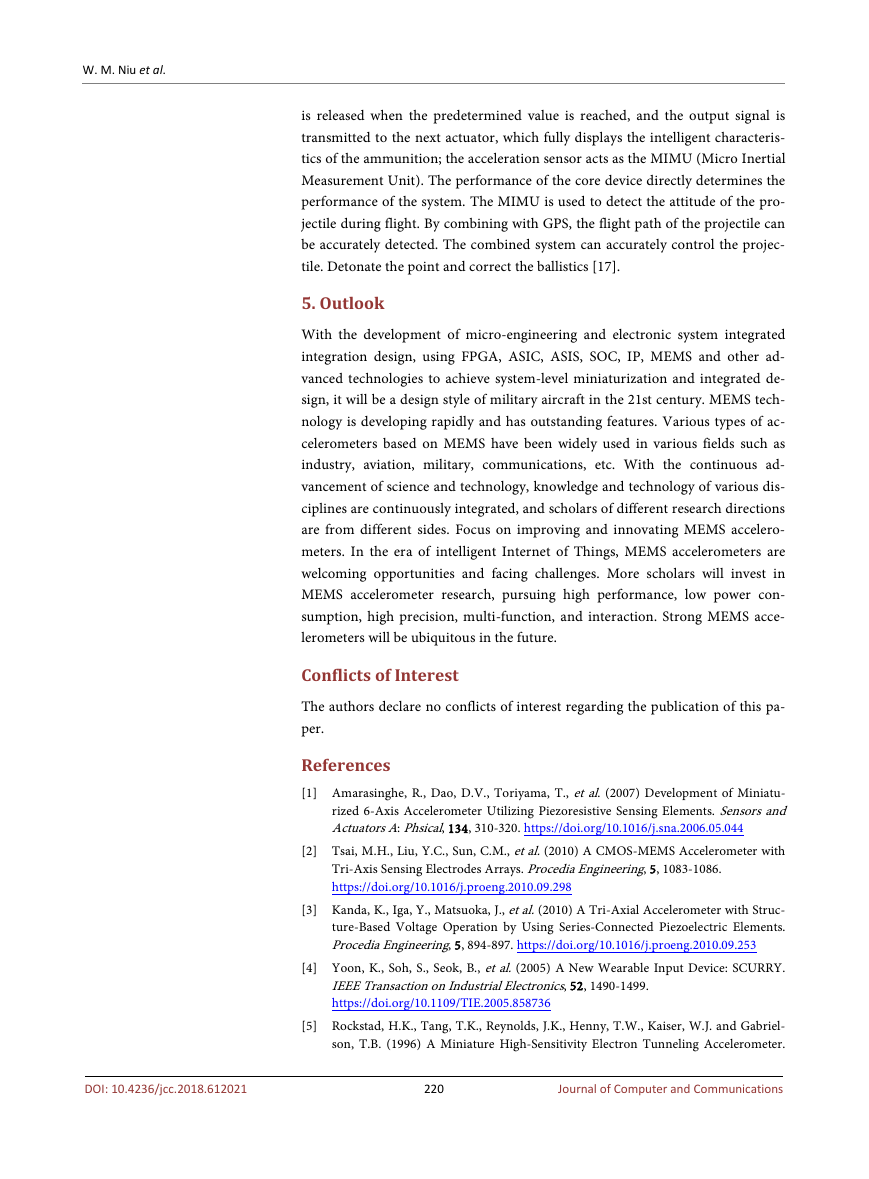








 2023年江西萍乡中考道德与法治真题及答案.doc
2023年江西萍乡中考道德与法治真题及答案.doc 2012年重庆南川中考生物真题及答案.doc
2012年重庆南川中考生物真题及答案.doc 2013年江西师范大学地理学综合及文艺理论基础考研真题.doc
2013年江西师范大学地理学综合及文艺理论基础考研真题.doc 2020年四川甘孜小升初语文真题及答案I卷.doc
2020年四川甘孜小升初语文真题及答案I卷.doc 2020年注册岩土工程师专业基础考试真题及答案.doc
2020年注册岩土工程师专业基础考试真题及答案.doc 2023-2024学年福建省厦门市九年级上学期数学月考试题及答案.doc
2023-2024学年福建省厦门市九年级上学期数学月考试题及答案.doc 2021-2022学年辽宁省沈阳市大东区九年级上学期语文期末试题及答案.doc
2021-2022学年辽宁省沈阳市大东区九年级上学期语文期末试题及答案.doc 2022-2023学年北京东城区初三第一学期物理期末试卷及答案.doc
2022-2023学年北京东城区初三第一学期物理期末试卷及答案.doc 2018上半年江西教师资格初中地理学科知识与教学能力真题及答案.doc
2018上半年江西教师资格初中地理学科知识与教学能力真题及答案.doc 2012年河北国家公务员申论考试真题及答案-省级.doc
2012年河北国家公务员申论考试真题及答案-省级.doc 2020-2021学年江苏省扬州市江都区邵樊片九年级上学期数学第一次质量检测试题及答案.doc
2020-2021学年江苏省扬州市江都区邵樊片九年级上学期数学第一次质量检测试题及答案.doc 2022下半年黑龙江教师资格证中学综合素质真题及答案.doc
2022下半年黑龙江教师资格证中学综合素质真题及答案.doc